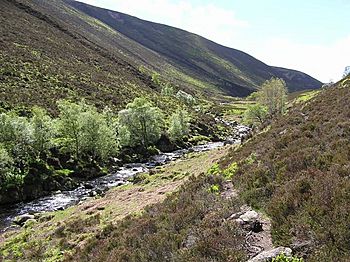Water of Aven facts for kids
Quick facts for kids Water of Aven |
|
|---|---|

Water of Aven
|
|
| Country | Scotland |
| Physical characteristics | |
| Main source | Loch Tennet |
| River mouth | Water of Feugh Whitestone, Scotland 57°01′05″N 2°35′55″W / 57.01794°N 2.59874°W |
The Water of Aven (also called A'an) is a lovely river in Scotland. It is a tributary, which means it's a smaller river that flows into a bigger one. The Water of Aven joins the Water of Feugh, which then flows into the much larger River Dee, Aberdeenshire. This river system is an important part of the Scottish landscape.
Contents
Where Does the Water of Aven Start?
The Water of Aven begins its journey at a place called Loch Tennet. A "loch" is the Scottish word for a lake. This special spot is where three old areas of Scotland, known as historic counties, meet. These counties are Aberdeenshire, Angus, and Kincardineshire.
How Long is the River?
From Loch Tennet, the Water of Aven flows for about 15 kilometers (about 9 miles). It travels through the beautiful Scottish countryside. Its journey ends when it meets the Water of Feugh near a place called Whitestone.
An Important Boundary River
For its entire length, the Water of Aven acts as a natural border. It forms the historic boundary between two of Scotland's old counties: Aberdeenshire and Kincardineshire. This means that for many years, the river has helped define where one area ends and another begins.
Home to Special Animals
The Water of Aven is very important for wildlife. The lower part of the river, about 4.5 kilometers (2.8 miles) long, is a protected area. It is part of the River Dee Special Area of Conservation. This special protection is given because the river is a vital home for two amazing animals:
- Atlantic salmon: These fish are famous for their long journeys. They are born in rivers like the Water of Aven, travel to the ocean, and then return to the same rivers to lay their eggs.
- Eurasian otter: These playful mammals love to live near clean rivers. They are excellent swimmers and hunters, often seen catching fish.
Protecting this part of the river helps make sure these animals have a safe place to live and thrive. It shows how important rivers are for the environment.

